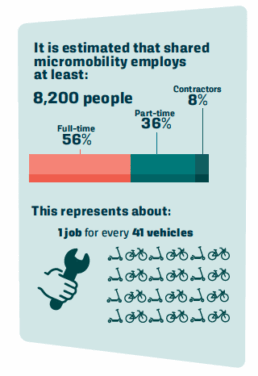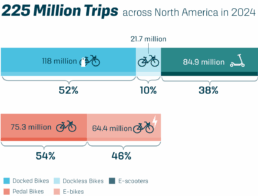The People that Make Shared Micromobility Happen
Think about your first time using a bikeshare bike for errands or a shared scooter to meet friends. Have you wondered how these vehicles and the system came to your community? Or perhaps you thought about the user flow for checking out a scooter or a bike, or the design of the handlebars and grips? Did you think about the people who do the many roles that make shared micromobility happen in your community? Maybe they are your friend or family member. Or perhaps that first ride inspired you to find a role in shared micromobility, joining others who are passionate about their work and motivated to create positive change in their communities.
Shared micromobility creates jobs.
NABSA estimates that the shared micromobility industry generates direct employment of approximately 8,200 full-time equivalent jobs in North America with operating companies and nonprofits, equipment and technology vendors, planning and engineering companies, and at city and government agencies. That represents 1 job for every 41 vehicles.
Shared micromobility creates a wide variety of good jobs for different skillsets.
It encompasses a breadth of roles that can get you working outside, connecting with the community, crunching numbers, developing the user experience, managing a team, and more. Let’s meet some of them:

The individuals most closely connected to the devices on the streets are the operations teams. These teams can include executive directors and general managers who guide the direction of the system in the community, operations staff spanning from team managers, field technicians who work on stations and equipment, mechanics who maintain the health of the bikes and scooters, and rebalancers who move vehicles to different locations. “I still get a spark of excitement every time I see someone on an Indego bike even 8 years after I started. I know what it takes to get that bike built, maintained, and in the right spot for that person to use it. My team works really hard, and I love that Philadelphians see us as a reliable form of transit!” says Drew Takacs, Operations Manager, Indego Bike Share.
Sara Khalil, Director of Operations for Bikeshare Pittsburgh, says, “Bikeshare is, to me, freedom. It’s independence. It’s fun. It’s for those who care. It’s for those who know there is more to life than ourselves. Bikeshare is an industry that values community, something that has shaped my life forever moving forward.”
Back at the office or warehouse, dispatch and distribution play an important role supporting the system by planning how to strategically move vehicles within the system to be available when riders need them. Émilie Turcott, Assistant Director of Distribution with BIXI says, “Dispatch and distribution are key to getting bikes where riders need them, when they need them. A great example is the summer season, when big festivities hit Montréal or any other city. Riding patterns change fast, and without a solid dispatch team and enough resources, things can quickly fall apart. And I’d say a strong connection between the dispatch and operational team is essential, everyone needs to understand the strategy for us to make it all work. At the end of the day, we’re here for the clientele, our job is to make sure their experience is smooth and reliable!” Customer service teams provide the first line of support to riders when they encounter issues or need help.
Marketing, communications and engagement teams develop plans to connect with the community to promote ridership, programs, and events. Gwendoline Planchenot, Marketing Specialist with Lyft Urban Solutions states, “I entered the bikeshare space somewhat organically, but it turned out to be a perfect fit. What inspires me most is encouraging people to choose transportation that’s not only more eco-friendly, but also healthier. There’s so much excitement around bikeshare; systems keep expanding, ridership keeps growing all around the world, and it’s amazing to see more and more people embracing this mode of transport and truly adopt their city’s bikeshare system!”
Shared micromobility equipment and technology vendors have teams that design the bikes and scooters, develop the user experience, create and support product technology, provide technical support to operators, manage inventory and logistics, and connect with communities that may be interested in shared micromobility or looking to update their equipment.
Both operators and equipment providers have finance teams that manage the organization’s money, ensuring financial operations run smoothly. They also have human resources teams that support employee relations and manage compensation and benefits, and employee relations. Shared micromobility also employs roles related to policy and government affairs.
Depending on the structure of the city and government agency, roles range from planning, active transportation coordination, oversight of shared micromobility permits, and management of the partnership with the operator. Roles within public agencies also play an important role in advocating for community support of a shared micromobility program.
“Seeing the government deliver real results — faster, smarter, and more affordably inspires my work in bikeshare and scootershare. Shared micromobility is one of the few spaces in transportation where we’re actively making things cheaper and better at the same time. In Chicago, we’ve lowered prices, expanded access, and added infrastructure — all while setting records ridership,” says David Powe, Assistant Commissioner with the Chicago Department of Transportation.
Adrian Leung with San Francisco Municipal Transportation Agency says, “Working in bikeshare is an opportunity to sit at the crossroads between private and public sectors, trying to figure out the right balance to improve our world. It asks good questions: How is ownership a burden? What collective models can move mobility (and non-mobility) structures for a better shared world, outside of profit? How does bikeshare become loveshare?”
Within planning organizations there are employees dedicated to shared micromobility work and projects. These roles help design systems and provide research and insights that can help support the system. “As someone who doesn’t own a car and uses shared micromobility on a regular basis, I love working in an industry that’s all about creating more transportation options for everyone. What really drives me is understanding how people change their mobility patterns when given new choices, and knowing that the projects I worked on for public and private clients help make getting around more accessible and fun,” says Alia Verloes, New Mobility Market Lead at Steer. Shared micromobility also includes technology companies that supply resources and tools for shared micromobility operators and providers. These organizations can help systems optimize operations with forecasting and planning tools, analyze data, provide reporting, and more!
Highlighting the roles and the diversity of people in shared micromobility, NABSA hosts a blog series called Workforce Diversity Wednesdays. The series also helps tell the story of how individuals came to their roles. Waffiyyah Murray, Indego Program Manager at the City of Philadelphia and NABSA Board President says, “I started working in shared micromobility in 2015 when Indego first launched here in Philadelphia. I led bike safety and education programming for Indego teaching people how to ride a bike and leading group rides throughout the community while at the Bicycle Coalition of Greater Philadelphia. I then transitioned over to the City of Philadelphia in 2017 first as the Indego Community Coordinator leading community engagement, then I managed the Better Bike Share Partnership, a national initiative focused on equity and access in shared micromobility before transitioning into my current position as Indego Program Manager where I oversee the bikeshare system for the city.”
Each year NABSA hosts an annual conference that provides individuals a chance to connect and learn from each other – it’s the only shared micromobility-focused conference globally and serves as the leading cross-sector gathering space for shared micromobility professionals. We encourage anyone engaged in the shared micromobility industry to attend: shared micromobility operators, equipment manufacturers, technology vendors, data and software providers, city staff working on shared micromobility and infrastructure that supports it, consultants, bike advocacy organizations, planners, community partners using shared micromobility as a tool for local priorities, shared micromobility researchers, and anyone interested to learn more about shared micromobility. This year, the 2025 Annual Conference will be hosted in Montreal, Quebec, October 15th to 17th.
Shared micromobility builds on the foundation of our core transportation systems and supports quality jobs. In 2024, at least 225 million shared micromobility trips were taken in 415 cities across North America, demonstrating shared micromobility’s important role in the public transportation ecosystem. These trips were taken on 333 thousand shared micromobility vehicles. The shared micromobility systems and vehicles are strategically designed, supported, and run by teams of people who are passionate about their work and motivated to create positive change in their communities. Ensuring support for shared micromobility aligns with its expanding scale and success is crucial for continued progress and job creation, contributing to thriving communities.


Shared micromobility transforms lives, not only by offering an essential transportation service that helps people get to where they need to go, but by creating jobs in communities in North America and across the globe. Next time you take a shared micromobility ride, give a shout out to all the people that help make shared micromobility happen!
